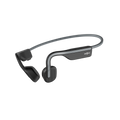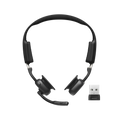Are you a beginner runner? Ready to progress to your next training goal? Coach Alysha Flynn from @WhatRunsYou on Instagram and TikTok shares her top tips for chasing your next PR. She has been a runner for 20+ years and a coach for beginner runners (like AfterShokz Athlete, Erin Azar @immrsspacecadet) for 13 years, offering virtual coaching to a close-knit team of women. Lace-up your shoes and read on for tips on setting a new personal record.
1.What factors should beginner runners consider when setting a new PR goal?
Find your “why”
What is at the very core of you that keeps you going? It should be visceral. You will identify it because you will feel it in your heart, and in every fiber of your being. There will be times in your journey when you will be tempted to make an excuse, but when you are strongly connected to your why, you will always do what needs to be done. You won’t look for a way out. You will step up to the challenge.
Build an aerobic base with easy conversational-paced miles.
70-80% of your weekly training mileage is easy, conversational-paced running. However, if you are new to running this could be 100% of your mileage. The physical benefits of being able to train at this pace will help you reach your next personal record. When you’re out there running, not just for minutes, but sometimes hours at your easy, conversational pace, you’re training your cardiorespiratory and muscular system to efficiently absorb, deliver, and utilize oxygen while removing waste products. At a cellular level, this is increasing the quantity and the size of your mitochondria. It’s at this pace where your body adapts to running and actually gets stronger. You will notice an improvement in your form, and strengthening in your joints, ligaments and tendons.
Recovery
You need to recover from workouts to improve and reach new milestones. You do this by balancing exertion and rest. This means having the discipline to take rest days and planning stepback weeks in your training.
Rest days should be taken weekly. A great place to schedule them is after a hard effort session that stresses the body. This allows you to absorb the gains from your workouts, adapt, and handle higher training intensities over time. Without it, you’ll risk breakdown, fatigue, plateauing and burnout. I generally plan stepback weeks every 3rd week for my beginner athletes who are training for a race to allow a reduction in their overall volume and intensity.
Experience
Improve your training experience by incorporating routine strength, flexibility, and mobility work into your training. Think of this as self-care for running. A little bit, done consistently, goes a long way. Keep it simple, and start with routines that take 10-15 minutes. You might want to consider scheduling strength training sessions after hard effort running workouts. Flexibility and mobility can also round off lower intensity running days but remember, they aren’t meant to fatigue you. (P.S. I’m a huge fan of The Wharton School of Health’s Active Isolated Stretch routine before every workout!)
2.What steps should beginner runners add to their training to track progress before a race?
In terms of technology, you can use wearable devices like a GPS watch to track analytics such as distance, pace, heart rate, cadence, and elevation. These devices are great for constant feedback, hitting training targets, and analyzing trends over time.
Beyond that, I like to keep it simple! I encourage all of my athletes to reflect and journal after their runs and races while their memories and emotions are fresh. The time spent in reflection will reveal possible training mistakes, help you to recognize patterns, and check in on your mindset. This is a great opportunity to identify and continue the strategies that worked for you, and change what didn’t.
Here are two questions I ask my athletes to reflect on: What Went Well and Why?
This prompts you to acknowledge, repeat, and automate good practices. You can pinpoint the behaviors that led to your positive outcome so you can build those into habits for future runs and races.
What could be improved?
Insight from this question can repel the things that don’t align with your overall training intention. When you perform worse than expected, this reflection will help identify potential mistakes and goal-blocking mindsets. Improvement opportunities are not always obvious, but consistent reflection and record-keeping will reveal patterns, and provide you with the space and objectivity that could be the key to unlock your next training breakthrough.
3.Are there any tools you’ve found useful for beginner runners to help train towards a new PR goal?
Think of your long runs as dress rehearsals for your race
Practice skills that you will need to compete at your best like fluid intake, fueling, and pacing. Experiment with clothing so that you are comfortable. Some fabrics irritate your skin, ride up and aren’t as breathable as you might think. Do this with shoes too, and don’t forget to break them in! No new shoes on race day! It’s important to iron these things out in training so that you can focus on race day.
Running buddies: A safe circle for constant support and encouragement
You can learn so much from other runners by sharing in their journeys. Running might appear to be a solo sport on the surface, but it’s an enormous community with so many runners just like you. Be bold! Find friends locally or online, or even through your local running store. They are great at connecting runners and providing insight - ask them about local meetups or upcoming races!
Tune into your body when training
Oftentimes, runners approach a run with the intention to “just get it over with.” This is not about just checking off a box. Time will pass anyway, so tap into the experience. Listen to the sound of your breath and your feet hitting the pavement. Use this feedback to judge your pace and respond accordingly. If you are becoming out of breath during an easy run, slow down. Respect your current fitness and enjoy the journey.
4.What advice would you give to beginner runners who are coming up against injuries and setbacks in pursuit of setting a new PR?
The highs of achievement can be a huge source of motivation for beginner runners. Who doesn't love achievement? It’s especially rewarding when you've been disciplined and thoughtful about training, where every mile planned was executed and marked off your calendar!
However, injury and setbacks do happen, and they can be absolutely devastating! When you start a running journey, you sign up for all of it: the highs of achievement and the lows of setback. None of us are an exception to this. We can't always be actively achieving, and sometimes things just happen.
Try not to be so hard on yourself. Remember that you are in control of your internal narrative. My coach once told me, “a training low is not the time to make a decision about your future”. Take things one day at a time. Coming back from injury or setback isn't linear. It's usually frustrating. It challenges you in ways you would never expect. You have to acknowledge and celebrate your progress even when it’s small.
When a setback collides with a race or goal, I call it a “not now moment.” Reevaluate, address the problem, learn, and come back stronger.
To find out more about Coach Alysha Flynn and What Runs You, follow her on Instagram and TikTok. Her plans will take you to the start line of your first or longest race with an easy-to-follow plan that includes your run training, mobility, stability, weight training, fuel guide, and a virtual community who always have your back. With Coach Alysha and the What Runs You community, there are no bad days in running!
Ready to start your training in the mornings? Check out our latest blog on 5 Cheat Codes for Jump-Starting your Morning Workout here.










